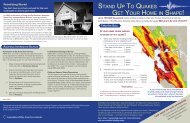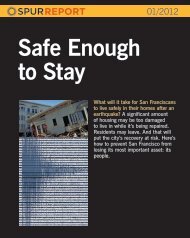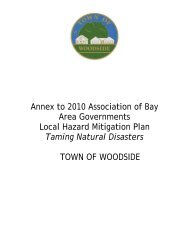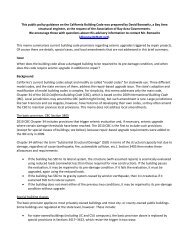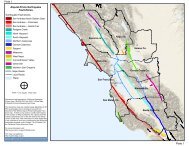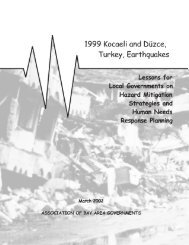Airport Liquefaction Susceptibility Analysis Report - ABAG ...
Airport Liquefaction Susceptibility Analysis Report - ABAG ...
Airport Liquefaction Susceptibility Analysis Report - ABAG ...
Create successful ePaper yourself
Turn your PDF publications into a flip-book with our unique Google optimized e-Paper software.
Fugro Consultants, Inc.<br />
Project No. 04.79221200<br />
1.0 INTRODUCTION<br />
The Association of Bay Area Governments (<strong>ABAG</strong>), under a grant issued by the California<br />
Department of Transportation (CalTrans), is revising and updating the earthquake-induced<br />
liquefaction susceptibility assessments conducted in 1999 for San Francisco International<br />
<strong>Airport</strong> (San Francisco; SFO) and Oakland International <strong>Airport</strong> (Oakland; OAK) (WLA, 1999),<br />
and is performing new assessments at three smaller General Aviation (GA) airports; Moffett<br />
Federal Airfield (Moffett; NUQ), located in Sunnyvale; Buchanan Field <strong>Airport</strong> (Buchanan; CCR),<br />
located in Concord; and Livermore Municipal <strong>Airport</strong> (Livermore; LVK), located in Livermore<br />
(Figure 1). The Moffett, Buchanan, and Livermore airports have been identified by <strong>ABAG</strong> as<br />
airports that could provide emergency relief or could temporarily accommodate increased air<br />
traffic or serve as a back-up for certain airport functions in the event that the one of the major<br />
commercial airports (SFO, OAK, and SJC) suffer severe damage from an earthquake. The San<br />
Jose International airport is not included in this assessment because a detailed susceptibility<br />
analysis was recently conducted.<br />
Major faults capable of producing large earthquakes that can result in strong ground shaking at<br />
the airports include the San Andreas, Hayward-Rogers Creek, and Concord-Green Valley faults.<br />
Other faults associated with the San Andreas fault system may also have the potential to<br />
generate large earthquakes (Figure 1). For this study we use earthquake scenarios considered<br />
‘likely’ by the 2007 Working Group on California Earthquake Probabilities (WGCEP, 2008) for<br />
the San Andreas, Hayward-Rogers Creek, and Concord-Green Valley faults. Earthquakes on<br />
these three faults would expose the airports to long-duration ground motions with peak ground<br />
accelerations in excess of 0.2 g (20 percent of the acceleration due to gravity). The distance<br />
between an earthquake epicenter and the farthest effects of liquefaction is directly related to the<br />
magnitude of the event (Tinsley et al., 1985), the presence of susceptible geologic and shallow<br />
hydrologic conditions, and the amplification of ground motion at lower frequencies. In addition,<br />
empirical correlations between ground shaking intensity and geology show that the distribution<br />
of amplified ground shaking is correlated with geologic conditions, and is most severe in<br />
alluviated basins that contain thick deposits of unconsolidated sediments.<br />
Previous damaging liquefaction occurred in the San Francisco Bay Area during the 1868<br />
Hayward earthquake, the 1906 San Francisco earthquake, the 1957 Daly City earthquake, the<br />
1983 Coalinga earthquake, and the 1989 Loma Prieta earthquake. Studies of the distribution of<br />
liquefaction features from these and other historical earthquakes demonstrate that liquefactionrelated<br />
damage is generally restricted to alluviated basins that contain shallow layers of lowdensity,<br />
saturated, granular sediment (i.e., sand) (Youd and Hoose, 1978; Tinsley et al., 1985,<br />
Holzer, 1998; Cetin et al., 2004a; Cubrinovski et al., 2011).<br />
1<br />
May 31, 2013



